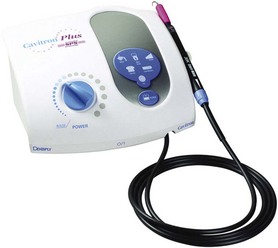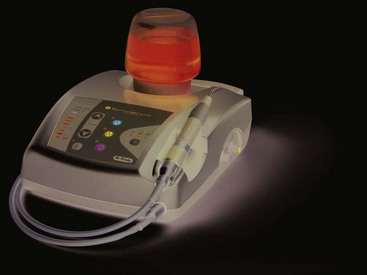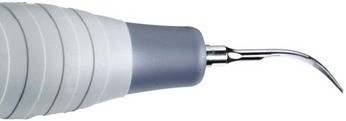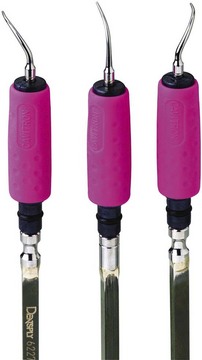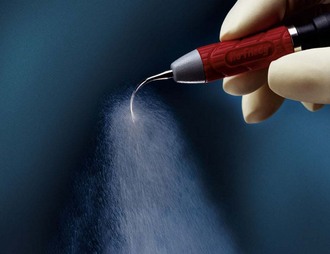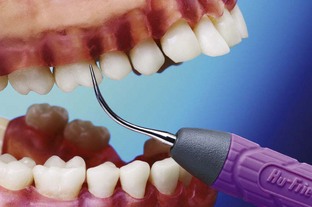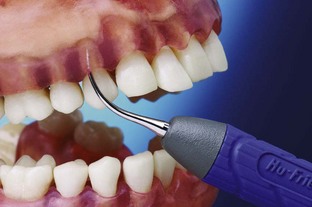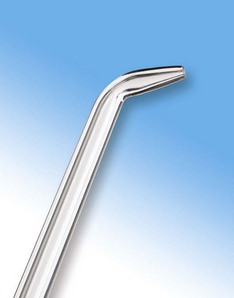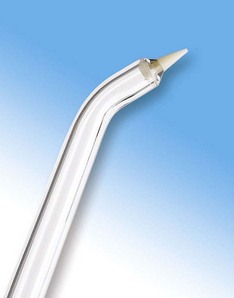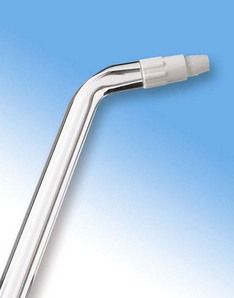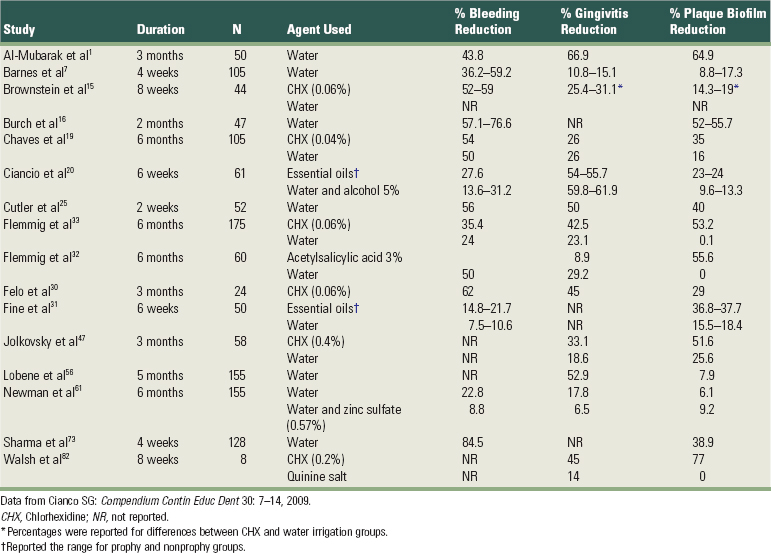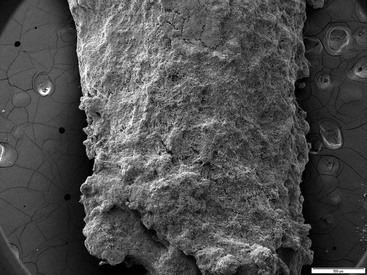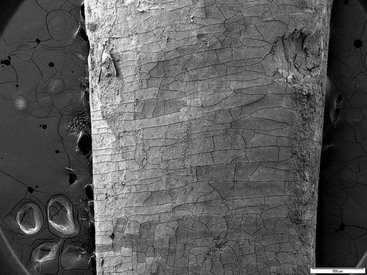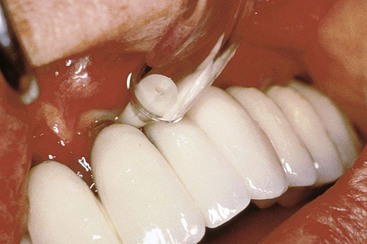CHAPTER 46 Sonic and Ultrasonic Instrumentation and Irrigation
For many years, practitioners have sought ways to enhance and prolong the outcomes from scaling and root planning. In the office setting, technologic advances and new designs of ultrasonic and sonic power scalers have transformed the role of power-driven oscillating instruments in periodontal therapy. At home, the pulsating dental water has been clinically proven to help patients maintain periodontal health by removing biofilm supragingivally and subgingivally and reducing inflammation.
Mechanism of Action of Power Scalers
Various physical factors play a role in the mechanism of action of power scalers. These factors include frequency, stroke, and water flow. In addition to rate of flow, the physiologic effects of water may play a contributing role in the efficacy of power instruments.
Water contributes to three physiologic effects that play a role in the efficacy. These are acoustic streaming, acoustic turbulence, and cavitation. Acoustic steaming is the unidirectional fluid flow caused by ultrasound waves. Acoustic turbulence is created when the movement of the tip causes the coolant to accelerate, producing an intensified swirling effect. This turbulence continues until cavitation occurs. Cavitation is the formation of bubbles in water caused by the high turbulence. The bubbles implode and produce shock waves in the liquid, creating further shock waves throughout the water. In vitro, the combination of acoustic streaming, acoustic turbulence, and cavitation has been shown to disrupt microflora.49,79-81
Type and Benefit of Power Instruments
Sonic units work at a frequency of 2000 to 6500 cycles per second and use a high or low speed air source from the dental unit. Water is delivered via the same tubing used to deliver water to a dental handpiece. Sonic scaler tips are large in diameter and universal in design. A sonic scaler tip travels in an elliptical or orbital stroke pattern. This stroke pattern allows the instrument to be adapted to all tooth surfaces.
Magnetostrictive ultrasonic devices work in a frequency range of 18,000 to 50,000 cycles per second. Metal stacks that change dimension when electrical energy is applied power magnetostrictive technology. Vibrations travel from the metal stack to a connecting body that causes the vibration of the working tip. Tips move in an elliptical or orbital stroke pattern. This allows the tip four active working surfaces (Figure 46-1).
Piezoelectric ultrasonic units work in a frequency range of 18,000 to 50,000 cycles per second. They have ceramic discs that are located in the handpiece power piezoelectric technology. They change in dimension as electrical energy is applied to the tip. Piezoelectric tips move in a linear pattern, giving the tip two active surfaces. A variety of insert tip designs and shapes are available for use (Figure 46-2).
Efficiency
Power instrumentation has the potential to make scaling less demanding, more time efficient, and more ergonomically friendly. Modified tip designs allow for improved access in many areas, including furcations. Newer, slimmer designs operate effectively at lower power settings, thus improving patient comfort. Sonic and ultrasonic tips can reduce the time needed for scaling.
Tip Designs
There are tips designed to remove heavy supragingival calculus or to definitively debride periodontal pockets. Large diameter tips are created in a universal design and are indicated for the removal of large, tenacious deposits. A high power setting is generally recommended. Thinner diameter tips may be site specific in design. The straight tip design is ideal for use in treating patients with gingivitis and deplaquing maintenance patients (Figures 46-3 and 46-4). The right and left contra-angled instruments allow for greater access and adaptation to root morphology. These inserts are designed to work in a low power setting. They can be used for exploration. The amount of water delivered for lavage can be controlled through the selection of either traditional flow or a focused tip delivery flow. Contra-angled designs and larger, ergonomic grips enhance comfort and ergonomics (Figure 46-5).
Clinical Outcomes of Power-Driven Instruments
Numerous clinical outcomes have been evaluated from the use of power-driven instruments. A systematic review of the literature on the treatment of chronic periodontitis found no difference in the efficacy of subgingival debridement using ultrasonic/sonic scalers versus hand instruments in the treatment of single-rooted teeth. A benefit for multirooted teeth could not be determined because of a lack of clinical data.78 Likewise, a review by the American Academy of Periodontology found no differences in outcomes between sonic, magnetostrictive, and piezoelectric scalers.27
It is well established that power driven instruments remove biofilms, bacteria, and calculus through mechanical action. With the advent of new designs and thinner tips, deplaquing of root surfaces may be effectively accomplished by power-scalers.* Both sonic and ultrasonic instruments have been shown to be effective in removing calculus similar to hand instrumentation.* Ultrasonic instruments through high-speed action produce a cavitational activity and acoustic microstreaming that some believe may help enhance the disruption of the bacteria in subgingival biofilms.
The primary expected clinical outcomes from scaling and root planing are a reduction in bleeding and probing depth and a gain in clinical attachment. In comparing power scalers to hand instruments, both types demonstrate similar outcomes for reductions in bleeding on probing and probing depth and gains in clinical attachment (see Table 46-1).†
TABLE 46-1 Increased Understanding of the Benefits of a Dental Water Jet
| Understanding of Periodontal Diseases (Approximate Years) | Significant Developments and Research in Dental Water Jet (DWJ) Technology |
|---|---|
| Nonspecific Plaque Era (1965) | |
| Plaque was considered to be a homogenous, toxic substance that caused gingivitis. Gingivitis could progress slowly to periodontitis. Amount of plaque and length of time plaque attached to tooth were paramount factors in disease. All plaque was considered essentially the same, and all plaque was considered bad.59 | DWJ initially introduced to dental community in early 1960s. Clinical and laboratory studies showed the following: |
| Specific Plaque Hypothesis Era (1975) | |
| Supragingival and subgingival plaque shown to be different. Supragingival plaque begins first, then with time can grow apically and evolve into subgingival plaque, which can cause bone destruction around a tooth.66 | Clinical studies in the 1970s through 1990s continued to show significant clinical reductions in bleeding, inflammation, and plaque formation using DWJ and marginal irrigation with water, chlorhexidine gluconate, and essential oils.* |
| Elevation of specific bacterial species associated with specific periodontal diseases. Periodontal pathogens are located subgingivally.62 | Studies show that DWJ irrigation with a jet tip can reach subgingival areas inhabited by periodontal pathogens.11,23,28,29 |
| Host Bacteria Interrelationship Era (1985) and Era of Periodontal Medicine (Present) | |
| Diabetes and other systemic diseases shown to make patient more susceptible to periodontal diseases. Additionally, control of periodontal disease shown to reduce need for insulin.38 | There is an improvement in clinical parameters in diabetic patients using DWJ and reduced inflammatory mediators over traditional routine oral hygiene regimens.1 Periodontal disease found to be an important risk factor for ALL forms of cerebrovascular disease, especially nonhemorrhagic stroke.34,85 Moderate-to-severe periodontitis increases systemic inflammation, which is associated with cardiovascular disease and gram-negative bacteria in periodontal pockets (biofilms) have been associated with arthromas.34 In 2009, at a consensus meeting, the American Journal of Cardiology and Journal of Periodontology issued guidelines for patients with atherosclerotic cardiovascular disease who have untreated or uncontrolled periodontitis that sated these patients should be treated with a focus on reducing and controlling the bacterial accumulations and eliminating inflammation.34 Clinical benefits of oral irrigation found to be related to reduction of proinflammatory mediators in serum (i.e., reduces systemic inflammation).26 Efficiency of DWJ irrigation at removing biofilm ex vivo and in vivo shown in scanning electron microscopy studies.39 DWJ irrigation (along with toothbrushing) is an effective alternative to dental floss for the reduction of bleeding, gingivitis, and plaque and in some cases, may provide superior results for reducing bleeding and gingivitis.7 |
Special Considerations
†References 4, 5, 10, 24, 51, 52, 57, 58, 64, 65, 71, and 77. Furcations present one of the greatest scaling challenges. In many instances, the opening of the furcation is narrower than the conventional hand instrument. For this reason, power scalers may be recommended as a means to improve access when scaling furcations (see Table 46-2).
Aerosol Production
Universal infection control procedures can help minimize the amount of aerosol produced. Harrel and Molinari42 recommend three levels of defense in the reduction of dental aerosols. The first recommended layer of defense is personal protective barriers such as a mask, gloves, and safety glasses. The second layer is routine use of an antiseptic preprocedural rinse. The final layer is the use of a high-speed evacuation device either by a dental assistant or attached to the instrument being used.41 In all cases and with all patients, the Centers for Disease Control and Prevention (CDC) guidelines for infection control should be adhered to.
Cardiac Pacemakers
Newer models of cardiac pacemakers often have bipolar titanium insulation that shields the units from the effects of sonic-type devices making magnetorestrictive, piezoelectric, and sonic instruments generally safe for use on people with pacemakers.70 However, a 1998 study by Miller et al60 found atrial and ventricular pacing was inhibited by electromagnetic interference produced by a magnetostrictive ultrasonic scaler. A sonic scaler was also tested but did not produce the same effect.61 In light of this, as a precaution, some practitioners have advocated using only hand instruments on individuals with pacemakers.35 There are no FDA warnings or precautions on the devices that prevent them from being used on patients with pacemaker. If in doubt, consult with the physician regarding any precautions or warnings from the manufacturer of the product.
Principles of Instrumentation
Ultrasonic technique is different from instrumentation with hand scalers. A modified pen grasp is used with an ultrasonic scaler along with an extraoral fulcrum (Figure 46-6). The purpose of the extraoral fulcrum is that it allows the operator to maintain a light grasp and easier access physically and visually to the oral cavity (Figures 46-7 and 46-8). Alternate fulcrums of cross arch or opposite arch fulcrums are acceptable alternatives.
Light pressure is needed with a power instrument. The tip is traveling at a set frequency in a set stroke pattern. Increased clinician pressure on the tip causes decreased clinical efficacy.
Sonic/ultrasonic instrumentation requires removal from the coronal to the apical portion of the deposit. This stroke pattern allows the insert to work at its optimal stroke pattern and frequency for quick effective deposit removal. A deplaquing stroke should be used when the focus is removal of biofilm and soft debris for the resolution of gingival inflammation. This stroke entails accessing every square millimeter of the tooth surface during ultrasonic deplaquing as a result of the limited lateral dispersion of the lavage subgingivally.
Home/Self-Applied Irrigation
The body of evidence on the dental water jet consistently has been shown to significantly reduce gingivitis, bleeding on probing, and periodontal pathogens.* These oral health improvements have been demonstrated with the use of either water or an antimicrobial agent. Emerging evidence indicates the dental water jet effectively removes biofilm40 and is as effective as dental floss when added to toothbrushing.7,74 Table 46-1 compares the understanding of periodontal disease to significant developments in dental water jet technology.
Mechanism of Action of Irrigation
The mechanism of action of irrigation occurs through the direct application of a pulsed stream of water or other solution. Studies have found pulsation and pressure to be critical components of an irrigation device.8,9,72 Pulsating devices have been shown to be three times as effective as a continuous-stream irrigating syringe.72 Pulsation provides for a compression and decompression phase that may account for expedient clearing of bacteria from the pocket.8 A pulsating device allows for control of the pressure rate. The majority of studies on home irrigation that have demonstrated clinical efficacy have been done using a dental water jet with 1200 pulsations per minute set on a medium to a high pressure setting (50 psi to 90 psi)8,9,73 (Figures 46-9 and 46-10). Dental water jets with varying pulsation and pressure are available, but like other self-care products, research from one product brand should not be extrapolated to other brands since they may have used a different pressure setting and pulsation rate.

Figure 46-9 A dental water jet with 1200 ppm and a pressure setting that ranges from 20 psi to 90 psi.
(Courtesy Water Pik, Inc, Fort Collins, CO.)
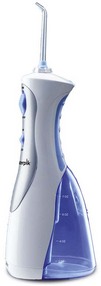
Figure 46-10 A cordless dental water jet, which also has 1200 ppm.
(Courtesy Water Pik, Inc, Fort Collins, CO.)
A pulsation rate of 1200 per minute has been shown to create two zones of hydrokinetic activity23: the impact zone, in which the solution initially contacts, and the flushing zone, in which the solution reaches into the subgingival sulcus40 (Figure 46-11). The outcome of hydrokinetic activity is subgingival penetration.
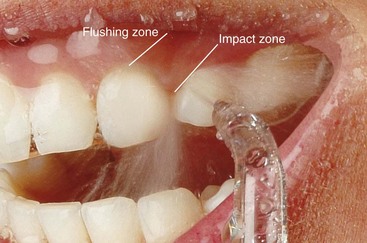
Figure 46-11 Pulsation creates two zones of hydrokinetic activity: the impact zone and the flushing zone.
(Courtesy Water Pik, Inc, Fort Collins, CO.)
Pulsating action of a jet tip.
(Animation courtesy of Water Pik, Inc, Fort Collins, CO.)
Home irrigation has been demonstrated to penetrate subgingivally with both a jet tip29 (Figure 46-12) and a soft, site-specific, subgingival tip13 (Pik Pocket subgingival irrigation tip, Water Pik, Inc, Fort Collins, CO) (Figure 46-13).
Supragingival irrigation is irrigation with a jet tip placed above the gingival margin resulting in penetration of a solution into the subgingival sulcus to approximately 50%.11,29
Depth of penetration with a dental water jet.
(Animation courtesy of Water Pik, Inc, Fort Collins, CO.)
The jet tip is generally used for full-mouth irrigation. Recently, other types of supragingival tips enhanced with soft, tapered bristles (Figure 46-14) have been introduced and shown to be effective in increasing the removal of plaque.39,73 Irrigation with the soft, site-specific tip is called subgingival irrigation. This refers to the placement of the tip, which is placed slightly below the gingival margin (Figure 46-15). The subgingival tip is used for the localized irrigation of a specific site such as a deep pocket, furcation, implant, or crown and bridge. Studies with this site-specific, subgingival tip show that it can deliver a solution into a pocket of 6 mm or less up to 90% of its depth.13 In pockets over 6 mm, the depth of penetration has been shown to be 64%.13
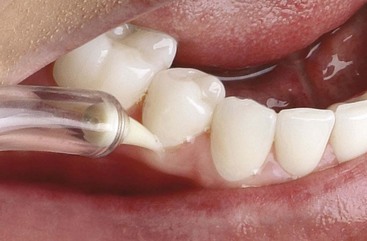
Figure 46-15 The Pik Pocket tip is gently placed slightly subgingivally.
(Courtesy Water Pik, Inc, Fort Collins, CO.)
Safety
Concerns regarding the safety of oral irrigation with regard to soft tissue damage and penetration of bacteria into the pocket have been voiced; although no scientific evidence exists to support these claims. Several investigators have evaluated the soft tissue and found no trauma or adverse reaction from using a pulsating oral irrigator. Researchers have found that irrigation reduces the amount of bacteria in the gingival crevice or periodontal pocket.* Specifically, Cobb et al and Drisko et al found that bacteria was reduced up to 6 mm.23,28
